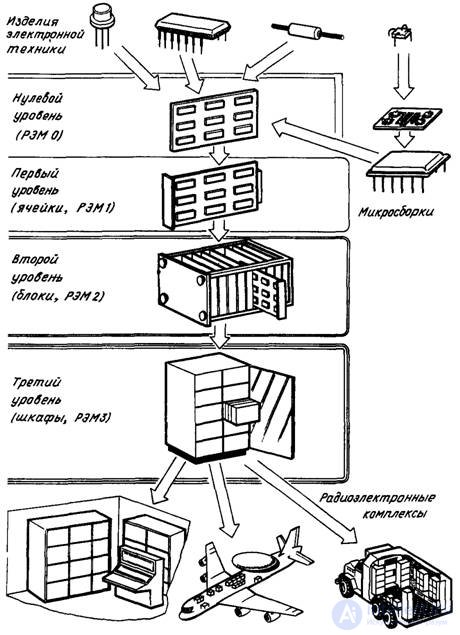Lecture
Bearing structures are taken as the basis for the decomposition of a distribution zone based on structural complexity in GOST 26632-85.
Bearing structure - a structural element or a set of structural elements designed to accommodate technical equipment and ensure their stability and durability under given operating conditions. By complexity, NCs are divided into three levels. The first level includes the supporting structures (HK1), designed to house the products of electronic equipment and electrical engineering and are included in the NC higher levels. The supporting structure of the second level (NK2) is intended for the placement of radio electronic devices made on the basis of HK1, the third level (NKZ) —for the placement of radio electronic networks, made on the basis of NK2 and (or) HK1.

When disaggregated by structural complexity, RESs are divided into three levels, uniquely related to NK levels:
Disaggregation by structural complexity of the RES in modular design is connected in GOST 26632--85 by the base bearing structures.
The basic supporting structure is a supporting structure designed to accommodate RES of various functional purposes, the dimensions of which are standardized. Despite the fact that in the GOST 26632-85 only the standardization of NK sizes is indicated as a sign of BNK, signs of a more general concept of basic structures should be extended to them. In the general technical sense, basic designs are products in which certain design decisions are kept unchanged (unification and typification) for a number of products. Since BNK is a special case of supporting structures, they are also divided into three levels: BNK 1, BNK2 and BNKS. The definitions of BNK2 and BNKZ are similar to NK2 and NKZ, and in the definition of BNK1 a supplement was introduced, due to the fact that four, rather than three, as in the general case, the level of unbundling were introduced for the electronic zone in zero, first, second and third.
Radioelectronic module (SEM) —functionally complete RES, made on the basis of the basic supporting structure of one or another level of unbundling and having the properties of constructive and functional interchangeability.
The first-level radio-electronic module (SEM 1) is a functionally complete cell or cassette made on the basis of BNK1 and having the properties of functional and constructive interchangeability, SEM2 is a block based on BNK2, REMZ is a cabinet based on BNZ.
The zero-level radio-electronic module (REMO) is a radio-electronic device designed to implement information conversion or signal conversion functions and performed on a constructive basis, dimensionally coordinated with BNK1 and possessing constructive and functional interchangeability properties. In fact, REMOs are REFs assembled on printed circuit boards and are introduced due to the widespread use of printed wiring.
In GOST 26632-85, when a RES is disaggregated by design complexity, as well as by disaggregation by functional complexity, the level of electronic engineering products (IET) is not entered. The choice of the lowest level of the REMO cell is justified from the point of view of the designer of the SEM, since it corresponds to the basic requirement for the design of the RES — a connection of indivisible component parts. At the same time, to ensure constructive compatibility in the design of complex radio-electronic systems, the level of complexes is reasonable,
Microassemblies are highlighted, since they are developed and manufactured by RES manufacturers, but after being produced, they are used along with other IET.
Comments
To leave a comment
Design and engineering of electronic equipment
Terms: Design and engineering of electronic equipment